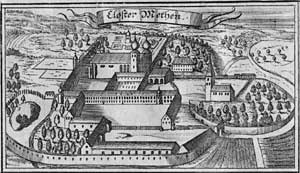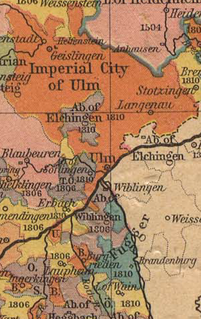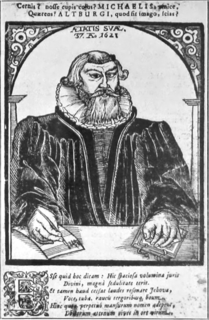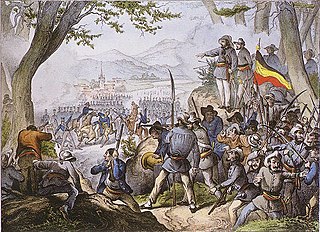
The Prussian Union of Churches was a major Protestant church body which emerged in 1817 from a series of decrees by Frederick William III of Prussia that united both Lutheran and Reformed denominations in Prussia. Although not the first of its kind, the Prussian Union was the first to occur in a major German state.

Metten Abbey, or St. Michael's Abbey at Metten is a house of the Benedictine Order in Metten near Deggendorf, situated between the fringes of the Bavarian Forest and the valley of the Danube, in Bavaria in Germany.

Elchingen Abbey was a Benedictine monastery in Oberelchingen in Bavaria, Germany, in the diocese of Augsburg.

The Thomanerchor is a boys' choir in Leipzig, Germany. The choir was founded in 1212. At present, the choir consists of about 90 boys from 9 to 18 years of age. The members, called Thomaner, live in a boarding school, the Thomasalumnat, and attend the Thomasschule zu Leipzig, a Gymnasium school with a linguistic profile and a focus on musical education. The younger members attend the primary school 76. Grundschule in der Manetstraße. Johann Sebastian Bach served as Thomaskantor, director of the choir and church music in Leipzig, from 1723 to 1750.

Lindow in der Mark, short: Lindow (Mark), is a town in the Ostprignitz-Ruppin district, in Brandenburg, Germany. It is located 14 km northeast of Neuruppin, and 29 km northwest of Oranienburg. The town is situated on an isthmus between the lakes Gudelacksee and Wutzsee.
Alfred Karl Gabriel Jeremias was a German pastor, Assyriologist and an expert on the religions of the Ancient Near East.

Heinrich Suter was a historian of science specializing in Islamic mathematics and astronomy.

Michael Altenburg was a German theologian and composer.

Söflingen Abbey was a nunnery of the Order of Poor Ladies, also known as the Poor Clares, the Poor Clare Sisters, the Clarisse, the Minoresses, or the Second Order of St. Francis. It was situated in the village of Söflingen, now part of Ulm in Baden-Württemberg, Germany. Being the oldest nunnery of this order in Germany, it was also its most important and most affluent.
The Gymnasium Carolinum in Osnabrück, Germany, was founded in 804 by Charlemagne, king of the Franks. It is reputedly the oldest school in Germany and is also one of the oldest surviving schools in the world.
Peter Agricola was a German Renaissance humanist, educator, classical scholar and theologian, diplomat and statesman, disciple of Martin Luther, friend and collaborator of Philipp Melanchthon.

The Kreuzschule in Dresden is the oldest surviving school in Dresden and one of the oldest in Germany. As early as 1300, a schoolmaster was mentioned. It was founded as a grammar school for the singers of the capella sanctae crucis, now the Dresdner Kreuzchor. The school is now a Protestant Gymnasium, officially called the Evangelisches Kreuzgymnasium.
The Burgschule or Oberrealschule auf der Burg was a secondary school (Oberrealschule) located originally in central Königsberg, Germany, and later in the suburban Amalienau quarter. It was the fourth oldest school in the city, behind Altstadt Gymnasium, Kneiphof Gymnasium, and Löbenicht Realgymnasium.
Ulrich Woronowicz was an East German Protestant theologian and writer.
Andreas Borum was a German painter and lithographer who also worked in stone, and a collector.

The Battle on the Scheideck, also known as the Battle of Kandern took place on 20 April 1848 during the Baden Revolution on the Scheideck Pass southeast of Kandern in south Baden in what is now southwest Germany. Friedrich Hecker's Baden band of revolutionaries encountered troops of the German Confederation under the command of General Friedrich von Gagern. After several negotiations and some skirmishing a short battle ensued on the Scheideck, in which von Gagern fell and the rebels were scattered. The German Federal Army took up the pursuit and dispersed a second revolutionary force that same day under the leadership of Joseph Weißhaar. The Battle on the Scheideck was the end of the road for the two rebel forces. After the battle, there were disputes over the circumstances of von Gagern's death.

The Neckar-Odenwald Limes is a collective term for two, very different early sections of the Upper Germanic-Rhaetian Limes, a Roman defensive frontier line that may have been utilised during slightly different periods in history. The Neckar-Odenwald Limes consists of the northern Odenwald Limes (Odenwaldlimes), a cross-country limes with camps, watchtowers and palisades, which linked the River Main with the Neckar, and the adjoining southern Neckar Limes (Neckarlimes), which in earlier research was seen as a typical 'riverine limes', whereby the river replaced the function of the palisade as an approach obstacle. More recent research has thrown a different light on this way of viewing things that means may have to be relativized in future. The resulting research is ongoing.
Karl Wilhelm Piderit was a German classical philologist and educator.

Christoph Langenmantel or Christoph Langenmantel vom Sparren was a nobleman, Carmelite friar, canon of Freising and a supporter of Martin Luther.












